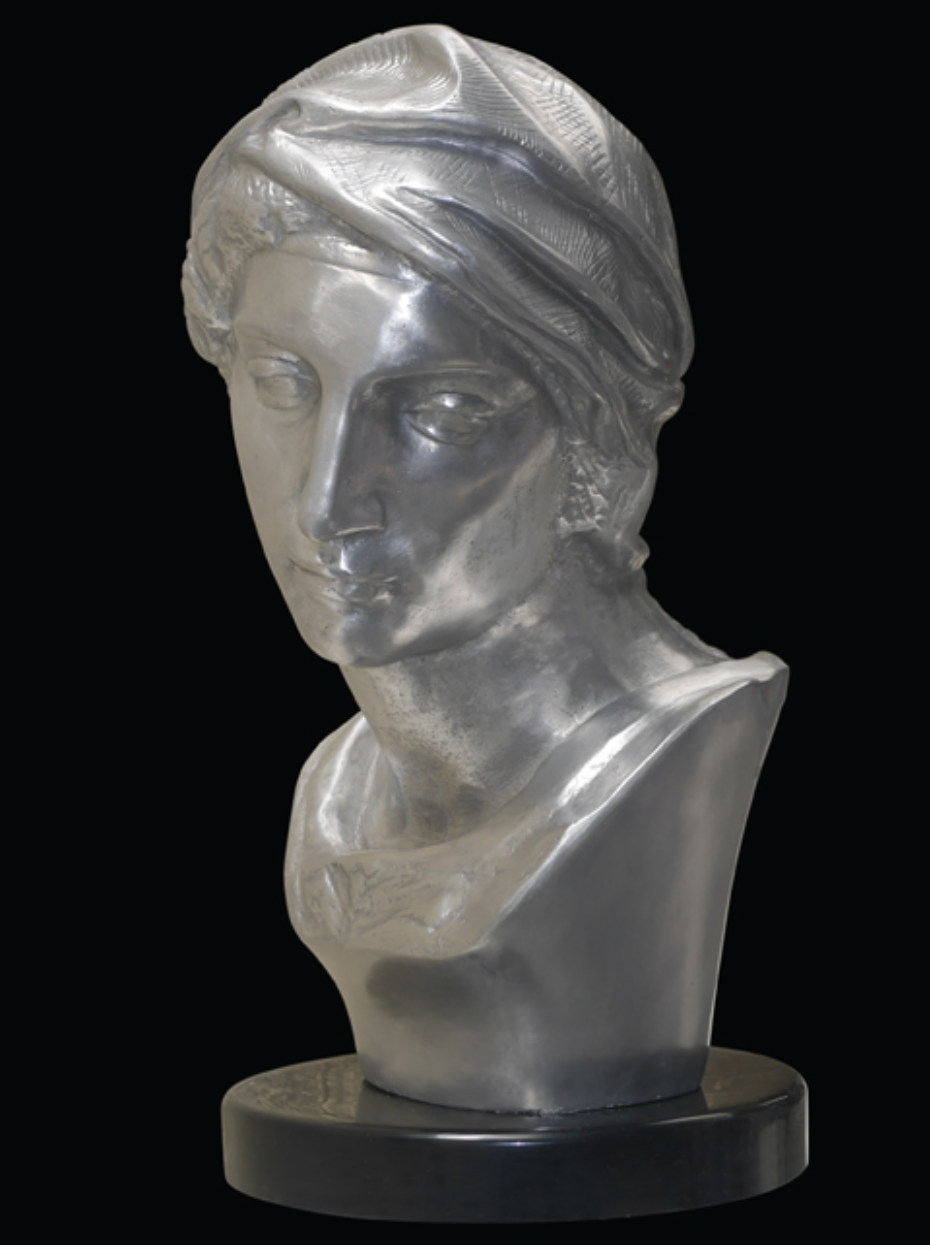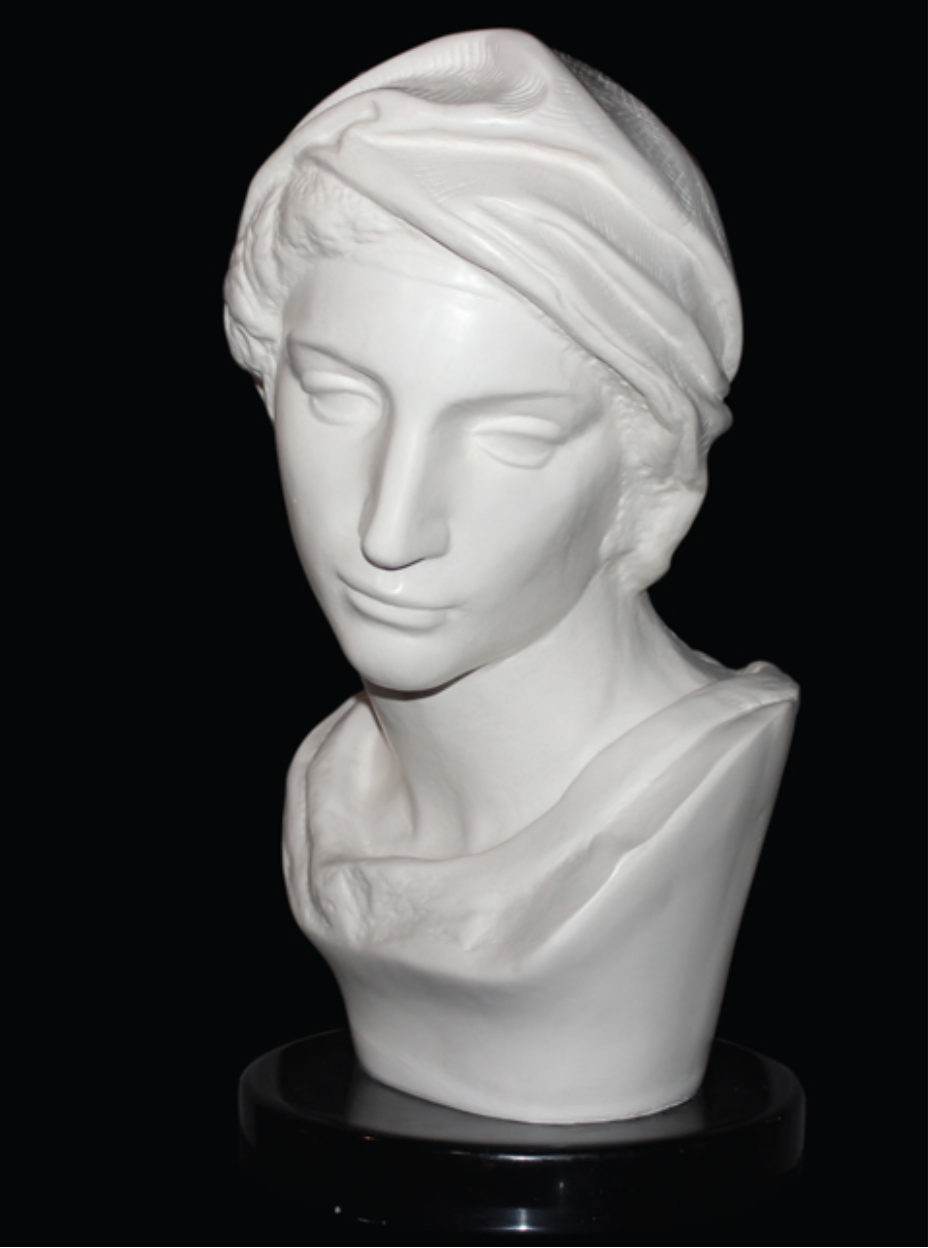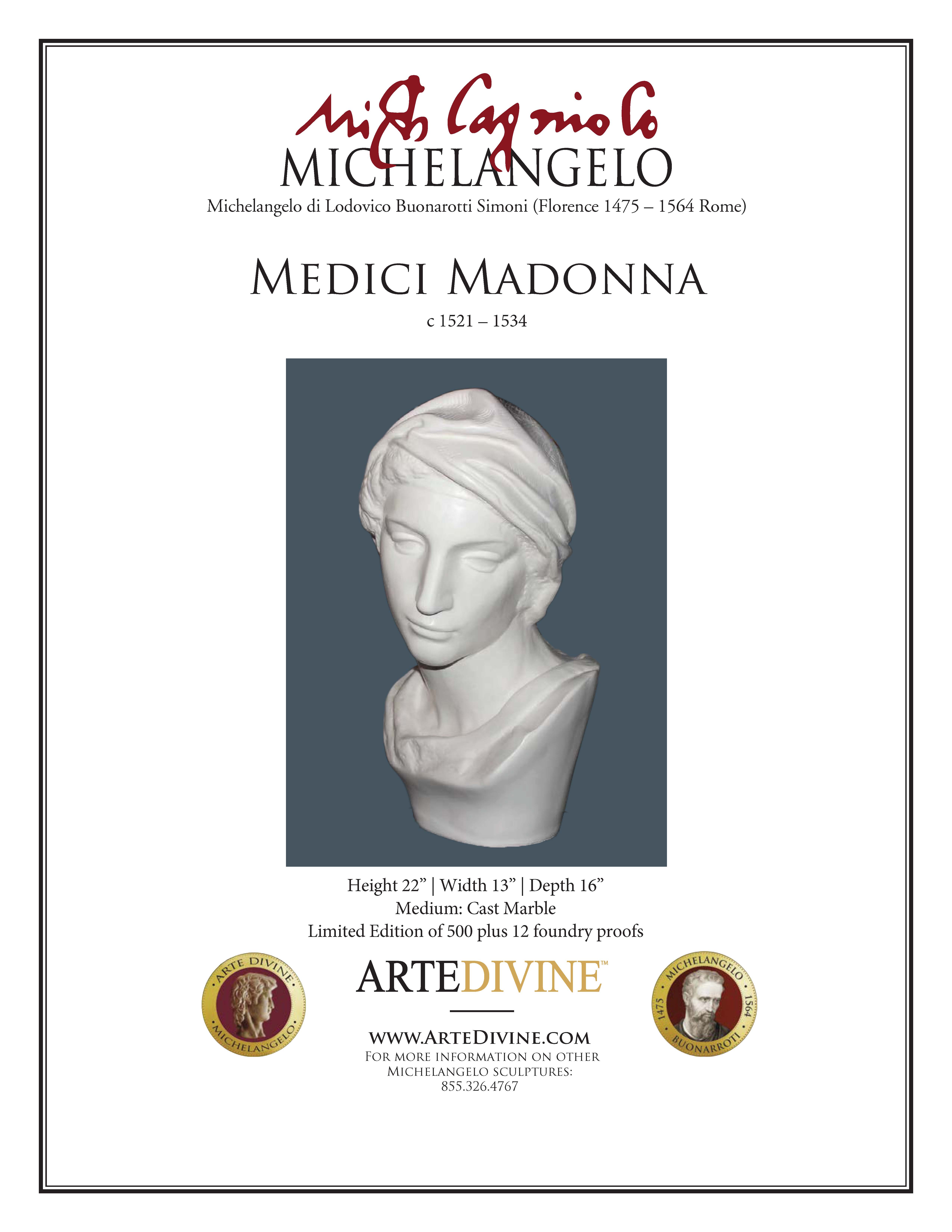MEDICI MADONNA
BY MICHELANGELO
The Medici Madonna (1521–1534; height 83 inches) Medici Chapel, San Lorenzo, in Florence.
Michelangelo left this marble group of a Madonna and her child unfinished in his Florentine studio when he departed for Rome in 1534. Although it was not installed until years later, the marble was probably intended for the Medici Chapel, as the centerpiece for the never executed tomb of the Medici princes.
Here the Virgin is seated, holding and the Christ Child with her left hand, sheltering Him in the hollow between her crossed legs and bosom. Surprisingly, the infant already has the curly hair and muscular limbs of a young Hercules. Like a superhuman force, he twists in a magnificent contrapposto movement, in an upward spiral, in contrast to the gentle, forward inclination of Mary’s torso. The smooth curves of His muscles are contrasted with the jagged forms of Mary’s drapery, which seem to oscillate from the bottom all the way up to her peaceful face. Apparently, Michelangelo wanted to express the power inherent the nursing Christ Child who would become the resurrected Savior.
Michelangelo di Lodovico Buonarotti Simoni
(Florence 1475 – 1564 Rome)
Medici Madonna
The Medici Madonna is in the funery chapel designed for the Medici dynasty in the Church of San Lorenzo in Florence. It is one of the many attempts by Michelangelo to depict the subject of the Virgin Mary and the Christ Child. It was made for the chapel in which Giuliano and Lorenzo Medici would be buried and represented in stone by Michelangelo. Michelangelo had an intimate relationship with every element of the New Sacristy, which would house the tombs of Giuliano and Lorenzo de Medici, including the architecture and sculpture.
Michelangelo would start on the work for the Medici Tombs in 1521, and would be commissioned by Cardinal Giulio de Medici, with support from his brother Pope Leo X. The history of the tomb project goes back to Cosimo de Medici, as he was the grandfather of the Medici family. The Medici commissioned several works from Brunelleschi, the famous Florentine architect, for the construction of the Basilica of San Lorenzo, which would be the Medici church, exclusively. Cosimo had his own intentions for the church of San Lorenzo as a family mausoleum and may have made plans known to Brunelleschi for those plans in the 15th century. It is widely believed that long before Michelangelo was called into the Medici tombs project, the Basilica of San Lorenzo had a decisive funerary function for the Medici family.
The Medici Chapels are homage to one of the most influential families in the patronage of the arts and the Italian Renaissance. The New Sacristy is a celebration of the Dynasty that will always be remembered as Florence’s ruling family during one of the most fruitful artistic time periods in history.
The Medici Madonna is described by Burckhardt as:
“Hardly more than hewn in the rough…Owing to a fault in the marble or a slip on the part of the artist, the right arm did not turn as it should have done and was therefore adjusted behind as we see it today. Probably this affected the rest of the statue, which for that reason was completed only schematically and inadequately.”
With this being said, the art historian Carl Justi adds:
“We live in an age of revision of all values, of a fundamental transformation of the world of culture: and thus it happens that the most criticized of Michelangelo’s marble figures, which previously was almost ignored, is now the most praised, as the most powerful expression of style.”
Charles de Tolnay says:
“…The souls of the dead find themselves once again in their true essence, through the eternal contemplation of life as symbolized by the Virgin and Child. The Two Dukes are not portrayed as the dead up to this time had been, reclining in their sarcophagi, but as seated men, watching the Virgin. Thus a spiritual unity links all the figures in the Chapel.”
Tolnay goes onto describe the compositional aspects of the Medici Madonna and Child;
“The Medici Virgin is placed opposite the altar and is the core of the composition of the Chapel. She is seated on a tall, narrow block, with only one of her feet touching the ground, which gives her being a strange lightness. Her diaphanous clothing shows the slender shapes of the body beneath. The naked, muscular Child sitting astride her breast. His back is turned to the public. The sap of life flowing in him seems to swell his body with new strength. The Mother is all abnegation; leaning on her right arm, she offers her body to the child. Her head is bowed, the face with its grave features marked with a pensive expression and a noble tenderness. Mother and Son seem to be one single being, embodying a striking image of the cyclic idea of life: eternally exhausted and eternally renewed.”
Like many of his depictions of the Madonna and Christ Child, the Virgin seems to gaze into nothingness as to show her spiritual remoteness, “as if sobered by the prospect of her child’s future suffering.” In several depictions this gaze, as if not recognizing the Christ Child or the viewer is something Michelangelo would do in some of his most poignant depictions of this holy subject.
Georg Brandes says in reference to the statues, including the Medici Madonna, in the Medici Chapel:
“Even though the work on these figures was tortuous, with one design following another, this was not seen as the statues came forth from their marble cocoons. None of them shows a trace of uncertainty. They stand there, perfect for all time, stamped by their inner destiny as though they could not be different even by a hair…The power of the choir in enhanced by the contrast between the great chiseled bodies and the delicate elements of the architecture.”
The Medici Madonna and Child can be seen in the New Sacristy of San Lorenzo, the church dedicated to the Medici Legacy, in Florence.
Selected Reference Literature:
Condivi, Vita di Michelangelo Buonarroti…1553; Giorgio Vasari, Lives of
The Most Eminent Painters, Sculptors, and Architects, 1550; Georgia
Illetschko, I Michelangelo, 2004; Nathaniel Harris, The Art of
Michelangelo, 1983; Charles de Tolnay, Michelangelo: Sculptor,
Painter, Architect, 1975; Robert Coughlan, The World of Michelangelo
1475-1564, 1972; Brandes, Georg. Michelangelo: His Life, His Times,
His Era, 1963; Bull, George. Michelangelo: A Biography, 1995; Murray,
Linda. Michelangelo, 1980; Beck, James. Michelangelo: The Medici
Chapel. “Michelangelo and the Medici Tombs,” 1993; Santi, Bruno.
Michelangelo: The Medici Chapels. “Michelangelo: Architect and
Sculptor in the New Sacristy,” 1993.



